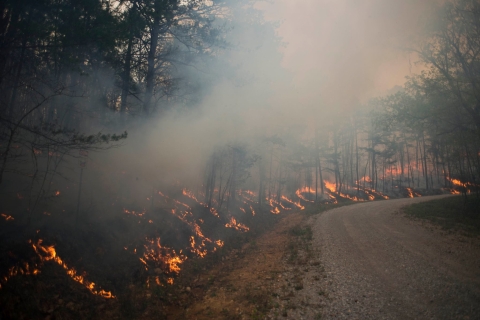What We Do
Prescribed burning is an important tool to manage habitat on the refuge. The regular application of slow-moving fire removes wildfire fuel, reduces invasive vegetation, and encourages the growth of plants that wildlife species use for food and cover. Prescribed burning maintains red-cockaded woodpeckers cluster areas (nesting trees) by reducing competing hardwoods. This establishes conditions similar to the bird’s native habitat, mature pine forest. In an open stand of tall pines, the woodpeckers are better protected from predators and require less foraging territory. Wild turkey and bobwhite quail thrive in fire-managed forests. These game birds require open forest, where they nest on the ground and feed on nuts, seeds, insects, and more. Small birds are attracted to lands maintained with fire. The secretive Bachman’s sparrow nests and feeds in mature pine forest and grassy fields. Warblers, buntings, and other Neotropical migratory birds inhabit shrubs bordering burn areas.
Forest management has been practiced on the refuge since its establishment, and its current woodlands are a result of this management. The refuge's forest provides wildlife the essentials (food, shelter, and homes). The forest also provides countless recreational opportunities for visitors.
Moist soil impoundments are managed within a closed area of the refuge to provide wintering waterfowl with food during their migrations. These impoundments are drained during the spring and summer, and planted or tilled in the fall, then re-flooded from the waters of Ross Branch Reservoir sanctuaries for wintering waterfowl.
Law Enforcement
The mission of the National Wildlife Refuge System Law Enforcement program is:
"Through education and enforcement we protect our employees, volunteers, and visitors; safeguard the public’s investment in facilities and equipment; and protect the integrity of the habitat and the wildlife resources of the National trust resource which is the 150 million acre National Wildlife Refuge System.”

